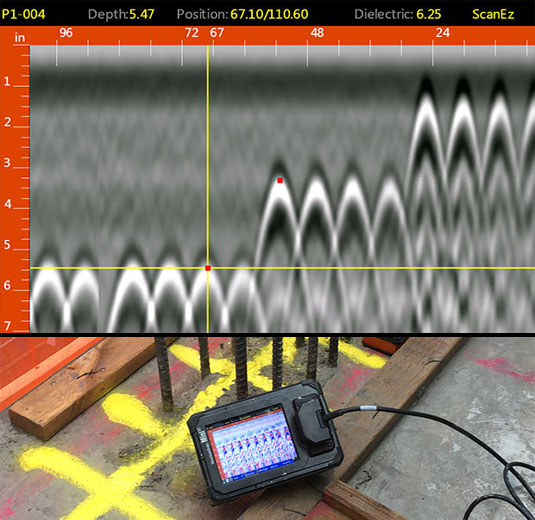Comprehensive Overview to Concrete Scanning Technologies
Comprehensive Overview to Concrete Scanning Technologies
Blog Article
Beyond the Surface Area: Leveraging Advanced Concrete Scanning Techniques for Unmatched Accuracy and Understanding
In the realm of construction and infrastructure maintenance, the mission for precision and thoroughness is unending. Advanced concrete scanning methods have become vital devices in this pursuit, supplying a look beneath the surface area to reveal a world of crucial understandings. By utilizing sophisticated modern technologies, professionals can reveal anomalies, assess the problem of concrete frameworks, and make educated decisions that shape the program of projects. The implications of these methods prolong much past simple surface-level evaluations, assuring a depth of precision and understanding that is unmatched.
Importance of Advanced Concrete Scanning
The significance of utilizing advanced concrete scanning methods exists in the unequaled accuracy they use for detecting sub-surface anomalies and ensuring architectural honesty. By employing innovative technologies such as ground-penetrating radar (GPR), electro-magnetic induction, and advanced sonar imaging, building and construction experts can delve under the surface of concrete frameworks with a degree of precision that much surpasses conventional examination techniques. Concrete Scanning. These methods allow the identification of concealed threats like rebar deterioration, spaces, channels, or post-tension cords that could compromise the security and security of a structure in time
Furthermore, progressed concrete scanning supplies indispensable understandings into the general condition of a concrete element without the demand for invasive measures, decreasing the danger of triggering damage throughout the analysis procedure. The capability to identify the precise place and depth of prospective problems enables targeted fixings and upkeep, inevitably lengthening the life expectancy of the structure and enhancing its performance. Essentially, the importance of innovative concrete scanning can not be overemphasized in the realm of construction and infrastructure maintenance, where precision and reliability are extremely important.
Types of Cutting-Edge Technologies

Anomalies and Issue Discovery

Along with GPR, concrete scanning strategies like thermography and impact-echo testing are likewise efficient in detecting anomalies and problems. Thermography uses infrared innovation to determine variants in surface temperature level, showing possible locations of problem such as delamination or moisture ingress. On the other hand, impact-echo screening involves examining acoustic reactions to identify voids, fractures, and other issues her latest blog within the concrete. By leveraging these innovative methods, experts can proactively attend to structural problems, making certain the long life and safety and security of concrete frameworks.
Assessing Concrete Problem
Just how can engineers accurately evaluate the condition of concrete frameworks to guarantee their long life and safety? Numerous innovative concrete scanning techniques are utilized for this function. Ground-penetrating radar (GPR) is commonly used to assess the internal structure of concrete, spotting gaps, splits, and various other anomalies that may compromise its strength.
Incorporating non-destructive screening techniques with aesthetic assessments permits for a thorough examination of concrete problem, making it possible for designers to recognize possible concerns early on and carry out prompt maintenance or repair work. By leveraging these advanced techniques, engineers can guarantee the long-term toughness and safety and security of concrete structures.
Enhancing Decision-Making Processes
In the realm of facilities administration, enhancing decision-making procedures is necessary for making sure the effective upkeep and longevity of concrete structures. Boosted decision-making procedures in concrete monitoring involve using advanced scanning strategies to gather in-depth information on the problem of structures. By leveraging modern technologies such as ground-penetrating radar and 3D imaging, stakeholders can make enlightened choices pertaining to fixing, substitute, or support approaches.
These advanced scanning methods provide very useful insights right into the internal structure of concrete, identifying prospective concerns such as voids, fractures, or deterioration that may not be noticeable externally. This level of thorough information enables aggressive maintenance planning, decreasing the risk of structural failings and enhancing the general lifespan of concrete frameworks.
In addition, by incorporating electronic documentation and view it analysis devices right into the decision-making process, stakeholders can track the development of concrete problems over time, allowing anticipating upkeep strategies and enhancing resource allowance. Ultimately, the assimilation of sophisticated concrete scanning strategies boosts decision-making processes by offering unequaled precision, insight, and efficiency in infrastructure management.
Verdict
Finally, progressed concrete scanning methods provide unmatched accuracy and insight in spotting anomalies, issues, and assessing the condition of concrete structures. By leveraging cutting-edge modern technologies, decision-making procedures can be improved, leading to more enlightened and effective options for preserving and repairing concrete framework. These methods play a vital function in ensuring the safety and security and long life of concrete frameworks, making them a crucial tool in the field next page of building and engineering.
In addition, advanced concrete scanning provides vital insights right into the general condition of a concrete aspect without the need for intrusive measures, decreasing the danger of causing damages during the evaluation procedure - Concrete Scanning. One more cutting-edge innovation is 3D X-ray scanning, which provides comprehensive photos of the interior framework of concrete, providing valuable info without the need for harmful screening. Furthermore, Concrete Cover Meters are made use of to determine the density of concrete cover over reinforcement bars properly. Improved decision-making processes in concrete management entail utilizing advanced scanning strategies to gather detailed information on the condition of frameworks.In conclusion, advanced concrete scanning methods provide unparalleled accuracy and understanding in detecting anomalies, issues, and examining the problem of concrete structures
Report this page